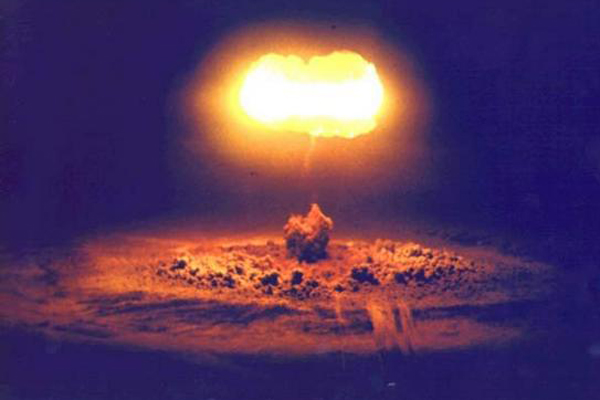How Does Nuclear Radiation Harm the Body?

The amount of radioactive material being released from the damaged nuclear reactors in Japan, and the eventual impact it will have on human health, are still being determined.
How does nuclear radiation harm the body, and what are the risks from long-term exposure to low levels after an accident? MyHealthNewsDaily spoke with experts about these questions.
How does radiation harm the body?
There's been some reported evidence that radioactive iodine and cesium are being released into the environment from the malfunctioning nuclear reactors in Japan, said Kathryn Higley, director of the Oregon State University department of nuclear engineering and radiation health physics.
As radioactive material decays, or breaks down, the energy released into the environment has two ways of harming a body that is exposed to it, Higley said. It can directly kill cells, or it can cause mutations to DNA. If those mutations are not repaired, the cell may turn cancerous.
Radioactive iodine tends to be absorbed by the thyroid gland and can cause thyroid cancer, said Dr. Lydia Zablotska, an assistant professor in the department of epidemiology and biostatistics at the University of California, San Francisco.
But radioactive iodine is short-lived and will be around for only about two months after an accident, said Andre Bouville of the National Cancer Institute, who has studied radiation doses from the fallout of the 1986 Chernobyl explosion in Ukraine. So, if the exposure to the air comes after that time, radioactive iodine does not pose a health risk, Bouville said.
Get the world’s most fascinating discoveries delivered straight to your inbox.
Children are most at risk for thyroid cancer, since their thyroid glands are 10 times smaller than those of adults, he said. The radioactive iodine would be more concentrated in them.
Radioactive cesium, on the other hand, can stay in the environment for more than a century. But it does not concentrate in one part of the body the way radioactive iodine does.
The Chernobyl accident released a plume of radioactive materials into the atmosphere in a fraction of a second. In the following years, the incidence of thyroid cancer among those exposed as children increased in Ukraine and nearby countries, Zablotska said. The cancer showed up between four and 10 years after the accident, Bouville said.
Children were exposed to radioactive material mainly from eating contaminated leafy vegetables and dairy. There have been no detectable health effects from exposure to radioactive cesium after the accident.
In general, it takes a pretty high dose of radiation to increase cancer risk, Higley said. For instance, there were reports that one Japanese worker was exposed to 10 rem (100 millisievert, mSV), a measurement of radiation dose. From that exposure, his lifetime cancer risk would go up about half a percent, Higley said. According to Higley, the dose is the equivalent of about five CT scans. Americans are exposed to about 0.3 rem (3 mSv) each year from natural sources, such as the sun.
Potentially, exposure to any type of radiation can increase cancer risk, with higher exposure increasing the risk, Bouville said.
No increases in cancer rates were observed after the release of radioactive from a power plant on Three Mile Island, Pa., in 1979, Zablotska said.
Radiation sickness
A person's risk of getting sick depends on how much radiation the body absorbs. Those exposed to high levels of radiation, about 200 rem, (2000 millisievert ) could develop radiation sickness, Bouville said. A chest X-ray is about 0.02 rem, (0.2 millisieverts mSv), according to the Interational Atomic Energy Agency.
People are exposed to about 0.24 rem (2.4 mSv) per year from natural background radiation in the environment, the IAEA says.
Radiation sickness is often fatal and can produce such symptoms as bleeding and shedding of the lining on the gastrointestinal tract, Zablotska said. About 140 people suffered from it as a result of the Chernobyl accident, Zablotska said.
A radiation dose of 40 rem, (400 mSv) per hour was reported at one of the Japanese power plants at one point following the March 11 earthquakes and tsunami that damaged their cooling systems, according to the IAEA. This is a high dose but was isolated to a single location, the IAEA says.
"That is definitely an area where you do not want to stay for prolonged period," Higley said. She notes that a total dose of 400 to 600 rem can be lethal. But the radiation levels have been decreasing after the observed spike, she said. She speculates the spike may have been due to the release of a puff of radioactive material when pressure dropped at the facility.
Follow MyHealthNewsDaily staff writer Rachael Rettner on Twitter @RachaelRettner.
This story was provided by MyHealthNewsDaily, a sister site to LiveScience.

Rachael is a Live Science contributor, and was a former channel editor and senior writer for Live Science between 2010 and 2022. She has a master's degree in journalism from New York University's Science, Health and Environmental Reporting Program. She also holds a B.S. in molecular biology and an M.S. in biology from the University of California, San Diego. Her work has appeared in Scienceline, The Washington Post and Scientific American.


